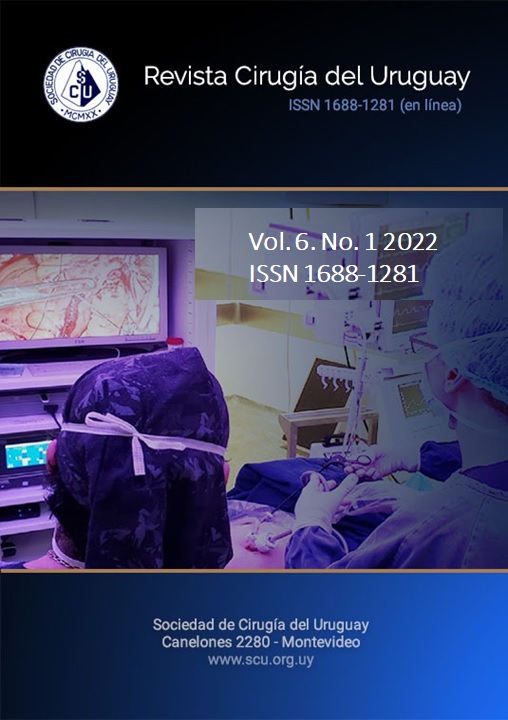Intraductal papillary neoplasm of the bile duct
DOI:
https://doi.org/10.31837/cir.urug.6.1.10Keywords:
neoplasms, cholangiocarcinoma, hepatolithiasisAbstract
Papillary intraductal neoplasia of the bile duct (NPIVB) is a rare entity characterized by exophytic papillary growth of the biliary epithelium towards the ductal lumen. Previously included in the group of tumors of the same name in pancreatic location, it presents obvious differences with them and since 2010 it has been considered a separate entity with demonstrated potential for malignancy towards cholangiocarcinoma
Downloads
Metrics
References
Albores-Saavedra J, Henson DE, Sobin LH. The WHO Histological Classification of Tumors of the Gallbladder and Extrahepatic Bile Ducts. A commentary on the second edition. Cancer. 1992 Jul 15;70(2):410-4. doi: 10.1002/1097-0142(19920715)70:2<410::aid-cncr2820700207>3.0.co;2-r.
Nakanuma Y, Kakuda Y, Uesaka K, Miyata T, Yamamoto Y, Fukumura Y, et al. Characterization of intraductal papillary neoplasm of bile duct with respect to histopathologic similarities to pancreatic intraductal papillary mucinous neoplasm. Hum Pathol. 2016;51:103-13. doi: 10.1016/j.humpath.2015.12.022.
Wan XS., Xu YY., Qian JY., Yang XB., Wang AQ, He L, et al. Intraductal papillary neoplasm of the bile duct. World J Gastroenterol. 2013;19:8595-604. doi: 10.3748/wjg.v19.i46.8595.
Rocha FG, Lee H, Katabi N, DeMatteo R, Fong Y, D’Angelica M, et al. Intraductal papillary neoplasm of the bile duct: A biliary equivalent to intraductal papillary mucinous neoplasm of the pancreas?. Hepatology. 2012;56:1352-60. doi: 10.1002/hep.25786.
Ohtsuka M, Shimizu H, Kato A, Yoshitomi H, Furukawa K, Tsuyuguchi T, et al. Intraductal papillary neoplasms of the bile duct. Int J Hepatol. 2014;2014:459091. doi: 10.1155/2014/459091
Egri C, Yap WW, Scudamore CH, Webber D, Harris A. Intraductal papillary neoplasm of the bile duct: Multimodality imaging appearances and pathological correlation. Can Assoc Radiol J. 2017;68:77-83. doi: 10.1016/j.carj.2016.07.005.
Kim WJ, Hwang S, Lee YJ, Kim KH, K.M. Park, C.S. Ahn, et al. Clinicopathological features and long-term outcomes of intraductal papillary neoplasms of the intrahepatic bile duct. J Gastrointest Surg. 2016;20:1368-75. doi: 10.1007/s11605-016-3103-5
Kloek JJ, van der Gaag NA, Erdogan D, Rauws EA, Busch OR, Gouma DJ, et al. A comparative study of intraductal papillary neoplasia of the biliary tract and pancreas. Hum Pathol, 2011;42:824-32. doi: 10.1016/j.humpath.2010.09.017
Hwang S, Lee YJ, Song GW, Park KM, Kim KH, Ahn CS, et al. Prognostic impact of tumor growth type on 7th AJCC staging system for intrahepatic cholangiocarcinoma: A single-center experience of 659 cases. J Gastrointest Surg. 2015;19:1291-304. doi: 10.1007/s11605-015-2803-6.
Luvira V, Pugkhem A, Bhudhisawasdi V, Pairojkul C, Sathitkarnmanee E, Luvira V, et al. Long-term outcome of surgical resection for intraductal papillary neoplasm of the bile duct. J Gastroenterol Hepatol. 2017;32:527-33
Published
How to Cite
Issue
Section
License
Copyright (c) 2022 Ángel Pierini, Leandro Pierini, Guillermo Ruiz, Brian Evans Rhys, Juan Pablo Elias, Rodrigo Meneghini

This work is licensed under a Creative Commons Attribution-NonCommercial 4.0 International License.
All articles, videos and images published in Revista Cirugía del Uruguay are under the Creative Commons CC licenses, which is a complement to the traditional copyright, in the following terms: first, the authorship of the referred document must always be acknowledged and secondly none of the article or work published in the journal may have commercial purposes of any nature. The authors retain their copyrights and give the magazine the right of first publication of their work, which will be simultaneously subject to the Creative Commons Attribution-NonCommercial 4.0 International License license that allows the work to be shared whenever the initial publication is indicated in this journal.






























